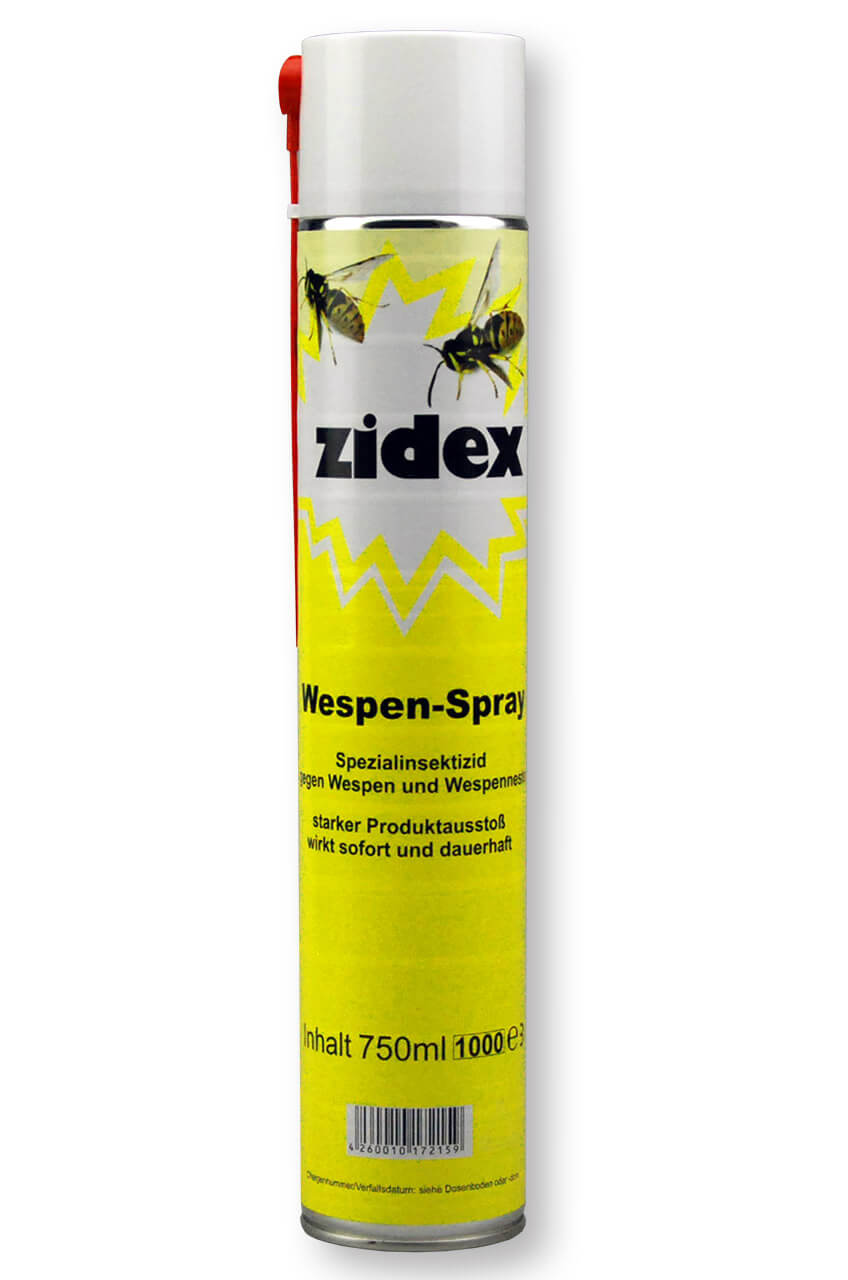End the wasp infestation - for the safe combat of wasps
Acts safely and swiftly against wasp nests and airborne wasps in outdoor areas. The special insecticide takes effect immediately and permanently. The specific can valve ensures a powerful product release.
Active Ingredients: Permethrin, Tetramethrin, Piperonylbutoxid, Geraniol
baua: Reg.-Nr. N-78250
Content: 750ml
Use biocidal products with caution. Always read the label and product information before use.
BAuA-Nr.: N-78250
Warnings, Hazard Notices, and Safety Instructions:
DANGER
 H222-H229 Extremely flammable aerosol. Container is under pressure: may burst if heated.
H222-H229 Extremely flammable aerosol. Container is under pressure: may burst if heated.
 H317 May cause allergic skin reactions.
H317 May cause allergic skin reactions.
 H304 May be fatal if swallowed and enters airways.
H304 May be fatal if swallowed and enters airways.
 H400 Very toxic to aquatic life.
H400 Very toxic to aquatic life.
 H410 Very toxic to aquatic life with long-lasting effects.
H410 Very toxic to aquatic life with long-lasting effects.
Precautionary Statements:
- P101 If medical advice is needed, have product container or label ready.
- P102 Keep out of reach of children.
- P210 Keep away from heat, hot surfaces, sparks, open flames, and other ignition sources. No smoking.
- P211 Do not spray towards an open flame or other ignition source.
- P251 Do not pierce or burn, even after use.
- P260 Do not inhale vapors/aerosols.
- P281 Use personal protective equipment as required.
- P312 Call a POISON CENTER/doctor if you feel unwell.
- P405 Store locked up.
- P410+P412 Protect from sunlight. Do not expose to temperatures exceeding 50°C.
- P501 Dispose of contents/container in accordance with local/regional/national regulations for hazardous waste.
General Safety Regulations:
Always read the label and product information before use. Use biocides safely. Follow the instructions to avoid risks to humans and the environment.
Directions for Use:
Zidex Wasp Spray is ready to use. Shake the can before use. Wasps may become aggressive. Protect your skin and wear face protection if necessary during treatment.
Fighting Free-Flying Wasps:
Spray flying wasps for about 2 seconds, aiming the spray directly at them using the can valve (without the spray nozzle). The special valve produces a strong output of the product with large spray droplets.
Fighting Nests:
Treat the nest early in the morning or late in the evening when wasps are inside. Attach the supplied spray tube to the can valve. From a distance of about 2-3 meters, direct the spray at the nest. Spray until the nest and all visible wasps are covered with the spray mist, and then move forward continuously, spraying, until the spray tube can be inserted directly into the nest opening. For larger nests, empty the entire can. Remove the nest only 1-2 days after treatment.
Notes:
- Do not use against protected species.
- Do not use in living spaces.
- Do not touch persons, animals, plants, food, or drinks.
- Do not spray on sensitive surfaces such as polished furniture and plastic surfaces. Cleaning is possible with common mild alkaline household cleaners.
- We cannot accept liability for any consequences related to the product's use as it is outside our control.
First-Aid Measures:
- Move affected persons to fresh air.
- Do not leave the affected person unattended.
- After Inhalation:
Ensure plenty of fresh air. Consult a doctor for safety. If unconscious, place the person in the recovery position and transport them safely.
- After Skin Contact:
Wash immediately with water and soap, and rinse thoroughly.
- After Eye Contact:
Rinse eyes with flowing water for several minutes with the eyelids open.
- After Ingestion:
Do not induce vomiting if swallowed (normally not possible). Seek immediate medical attention. Risk of aspiration.
Most Important Acute and Delayed Symptoms and Effects:
After intense inhalation, the following symptoms may occur:
- Headache
- Drowsiness
- Dizziness
General Protection and Hygiene Measures:
- Do not eat, drink, smoke, or sniff while working.
- Keep away from food, drinks, and animal feed.
- Immediately remove contaminated clothing.
- Wash hands before breaks and at the end of the workday.
- Store protective clothing separately.
- Do not inhale gases/vapors/aerosols.
Fire-Fighting Measures:
Suitable Extinguishing Media:
- CO2, dry powder, or water spray.
- For larger fires, use water spray or alcohol-resistant foam.
Specific Hazards Arising from the Substance or Mixture:
- Formation of toxic gases when heated or in a fire.
- Risk of container rupture and injury from fire and heat.
Special Protective Equipment:
- Use respiratory protection.
- Wear a full protective suit.
Measures in Case of Unintended Release:
Personal Precautions, Protective Equipment, and Emergency Procedures:
- Avoid eye/skin contact and inhalation.
- Keep ignition sources and vehicles (potential ignition sources) away.
- Ensure adequate ventilation.
- Use appropriate respiratory protection.
- Wear protective equipment.
- Keep unprotected persons away.
Environmental Precautions:
- Notify the competent authorities in case of accidental entry into water or sewage systems.
- Do not allow the product to enter the sewage system, surface water, or groundwater.
Methods and Materials for Containment and Cleanup:
- Ensure adequate ventilation.
Handling and Storage:
Safety Measures for Safe Handling:
- Avoid skin and eye contact and inhalation.
- Provide adequate ventilation/respiration extraction at the workplace.
- Handle containers with care.
Fire and Explosion Protection:
- Do not spray towards flames or on hot objects.
- Keep away from ignition sources—no smoking.
- Have respiratory protection available.
- Protect containers from sunlight and temperatures exceeding 50°C (e.g., from light bulbs).
- Do not force open or burn containers, even after use.
Conditions for Safe Storage, Including Incompatibilities:
- Storage:
Follow local regulations for storing pressurized gas containers.
- Storage Instructions:
Keep separate from food, animal feed, and beverages.
Store separately from oxidizing agents.
- Storage Temperature Range: 15 - 35°C
- Storage Class: 2B (pressurized gas containers)
Disposal Instructions:
- Full Aerosol Cans: Dispose of as hazardous waste.
- Empty Aerosol Cans: Can be disposed of in recyclable materials collection.
- Take to a hazardous waste collection point or dispose of through a special waste collector.






 H222-H229 Extremely flammable aerosol. Container is under pressure: may burst if heated.
H222-H229 Extremely flammable aerosol. Container is under pressure: may burst if heated. H317 May cause allergic skin reactions.
H317 May cause allergic skin reactions. H304 May be fatal if swallowed and enters airways.
H304 May be fatal if swallowed and enters airways. H400 Very toxic to aquatic life.
H400 Very toxic to aquatic life.



